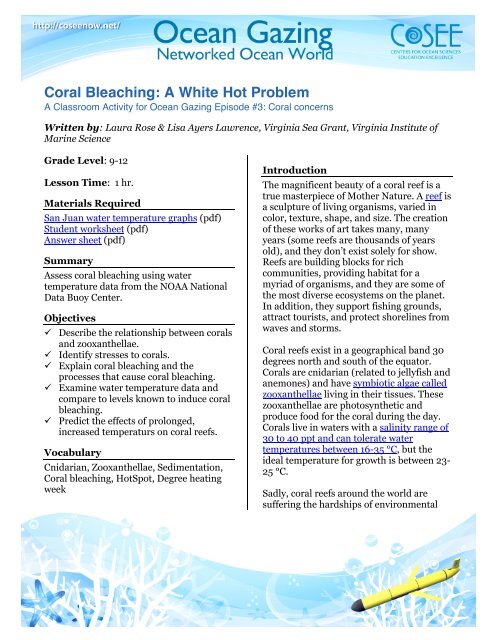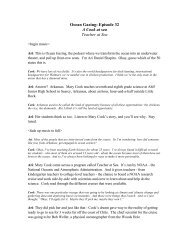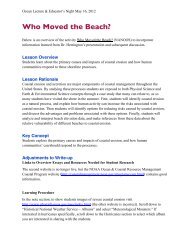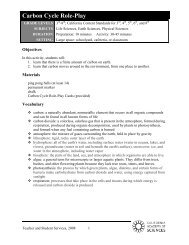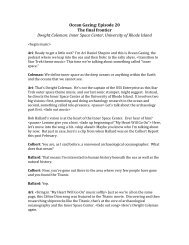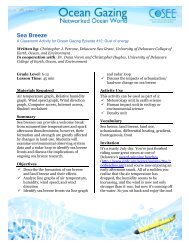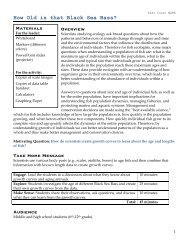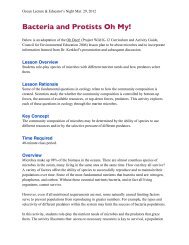Coral bleaching: A white hot problem (pdf) - cosee now
Coral bleaching: A white hot problem (pdf) - cosee now
Coral bleaching: A white hot problem (pdf) - cosee now
Create successful ePaper yourself
Turn your PDF publications into a flip-book with our unique Google optimized e-Paper software.
<strong>Coral</strong> Bleaching: A White Hot ProblemA Classroom Activity for Ocean Gazing Episode #3: <strong>Coral</strong> concernsWritten by: Laura Rose & Lisa Ayers Lawrence, Virginia Sea Grant, Virginia Institute ofMarine ScienceGrade Level: 9-12Lesson Time: 1 hr.Materials RequiredSan Juan water temperature graphs (<strong>pdf</strong>)Student worksheet (<strong>pdf</strong>)Answer sheet (<strong>pdf</strong>)SummaryAssess coral <strong>bleaching</strong> using watertemperature data from the NOAA NationalData Buoy Center.Objectivesü Describe the relationship between coralsand zooxanthellae.ü Identify stresses to corals.ü Explain coral <strong>bleaching</strong> and theprocesses that cause coral <strong>bleaching</strong>.ü Examine water temperature data andcompare to levels k<strong>now</strong>n to induce coral<strong>bleaching</strong>.ü Predict the effects of prolonged,increased temperaturs on coral reefs.VocabularyCnidarian, Zooxanthellae, Sedimentation,<strong>Coral</strong> <strong>bleaching</strong>, HotSpot, Degree heatingweekIntroductionThe magnificent beauty of a coral reef is atrue masterpiece of Mother Nature. A reef isa sculpture of living organisms, varied incolor, texture, shape, and size. The creationof these works of art takes many, manyyears (some reefs are thousands of yearsold), and they don’t exist solely for show.Reefs are building blocks for richcommunities, providing habitat for amyriad of organisms, and they are some ofthe most diverse ecosystems on the planet.In addition, they support fishing grounds,attract tourists, and protect shorelines fromwaves and storms.<strong>Coral</strong> reefs exist in a geographical band 30degrees north and south of the equator.<strong>Coral</strong>s are cnidarian (related to jellyfish andanemones) and have symbiotic algae calledzooxanthellae living in their tissues. Thesezooxanthellae are p<strong>hot</strong>osynthetic andproduce food for the coral during the day.<strong>Coral</strong>s live in waters with a salinity range of30 to 40 ppt and can tolerate watertemperatures between 16-35 °C, but theideal temperature for growth is between 23-25 °C.Sadly, coral reefs around the world aresuffering the hardships of environmental
stress. <strong>Coral</strong>s are susceptible to a number ofstresses, both natural and human-induced,including pollution, sedimentation,increased temperature, and physicaldamage by humans. These stresses can killcoral reefs outright, or make the coralsmore susceptible to disease.Average global sea temperature has beenrising gradually over several decades, 0.7 °Cin the past 30 years alone, which isgenerally believed among the scientificcommunity to be due to global warming.This thermal stress can cause coral<strong>bleaching</strong>, or the loss of zooxanthellae fromthe coral tissues. Since the zooxanthellaeare what give the coral tissue their color, theloss of them make the coral appear <strong>white</strong>.With the loss of the p<strong>hot</strong>osynthetic algae,corals lose their primary food source andcan die.<strong>Coral</strong>s which had thrived for hundreds ofyears suddenly died in 1998. It was theworst year ever recorded globally for coral<strong>bleaching</strong> up to that point, and it broughtthe <strong>hot</strong>test sea surface temperatures since1982. View a NOAA animation of 1998’scoral <strong>bleaching</strong> <strong>hot</strong> spots (areas where thesea surface temperature exceeds theclimatological expected maximum for thatregion by 1° C or more, colored orange tored) and coral <strong>bleaching</strong> events (markedwith asterisks).In 2005, sustained high sea surfacetemperatures caused even worse coral<strong>bleaching</strong> in the Caribbean. According tosome scientists, the 2005 Caribbean<strong>bleaching</strong> events were bigger than all theprevious 20 years combined. The effectsfrom this are still being felt <strong>now</strong>. Recently,there was a large die off of corals off thecoast of Puerto Rico and the U.S. VirginIslands. These corals had survived the highheat of 2005 but were weakened andsuccumbed to <strong>white</strong> plague disease. Thefollowing data activity examines NOAAwater temperature data for San Juan,Puerto Rico for 2005 through 2008. We willcompare the observed water temperaturewith the k<strong>now</strong>n stressful temperature levelfor coral reefs and discuss the affects.Data Activity<strong>Coral</strong>s can survive in water temperatures upto 35 °C, however the optimal growthtemperature for corals is around 25 °C.Researchers have determined that, for anygiven area, water temperatures of 1 °Cabove the expected summertime maximumtemperature is stressful to corals. If an areaexperiences this it is called a coral <strong>bleaching</strong>HotSpot. If the thermal stress lasts for aweek or longer, the stress accumulates. Tomeasure this, researchers use a degreeheating week (DHW) value. If thetemperature is above the expected averagemaximum for one week, the DHW is 1. Ifthe temperature is 2 °C higher than theexpected maximum for one week then theDHW value is 2. You can also get a DHWvalue of 2 if the temperature is 1 °C higherfor 2 weeks.For Puerto Rico, the expected summertimemaximum temperature is 28.5 °C. Thismakes the DHW level 29.5 °C.Print the following graphs of observed dailywater temperature for San Juan, PuertoRico for 2005 - 2008. These data werecollected by the NOAA National Data BuoyCenter. Each year has its own graph, andthe last graph shows all years (2005 - 2008)compiled.In the graphs, the vertical lines mark oneweektime periods. The yellow line marksthe 1 DHW level of 29.5 °C and the red linemarks the 2 DHW level of 30.5 °C.A study conducted by researchers from theUniversity of Puerto Rico found that 54<strong>Coral</strong> Bleaching: A White Hot Problem Page 2
days of 29.5 °C water temperatures or 10days of 30.5 °C water temperaturescorrelated with severe coral <strong>bleaching</strong>.Print out the student worksheet, and fill inthe answers to the following questions.ü For each year, approximately what datedid the water temperatures of San Juan,PR hit 1 °C above expected summertimemaximum?ü For each year, approximately what datedid the water temperatures hit 2 °Cabove expected summertimemaximum?ü What date did the water temperaturedrop and remain below the 2 °C aboveexpected maximum for the remainderof the year?ü What date did the water temperaturedrop and remain below the 1 °C aboveexpected maximum for the remainderof the year?ü Approximately how many weeks overthe year were temperatures 1 °C aboveexpected maximum?ü Approximately how many weeks overthe year were temperatures 2 °C aboveexpected maximum?ü How many Degree Heating Weeks(DHW) were there for the year?(Remember: 1 week at 1 °C aboveexpected maximum = 1 DHW and 1week at 2 °C above expected maximum= 2 DHWCompare your answers to the BridgeAnswer Sheet.Discussion Questionsü As you k<strong>now</strong>, 2005 was a year of highwater temperatures. How do the years2006-2008 compare to 2005?ü What trend, if any, do you see in thenumber of DHWs over the 2005-2008time period? Is this a long enoughperiod of time to determine a trend? Ifnot, how long a time period would yousuggest?ü Based on the 2005-2008 data, whatwould you expect to see for watertemperatures in San Juan, PR for2009? (Access the San Juan, PR NOAAbuoy data to see the current watertemperature.)ü Over the next few decades, if watertemperatures continue to remain highfor long periods of time at a stretch(resulting in significant DHWs peryear), how do you think this will affectcoral reefs? What impact would thishave on the ecosystem? On the localeconomy?<strong>Coral</strong> reefs are considered to be the key totropical ocean ecosystems, and marinescientists warn that their decline could be aprelude to widespread ecological damage.Want to help reverse the trend? Here are 25things you can do to save coral reefs.Related Resources<strong>Coral</strong> reef, Physical oceanography, Climate,Ocean Observing SystemsReferencesLevinton, Jeffrey. “<strong>Coral</strong> Reefs.” BIO/GEO 353– Marine Ecology. Stony Brook University.http://life.bio.sunysb.edu/marinebio/coralreef.html“Zooxanthellae… What’s That?” <strong>Coral</strong>s. NOAANational Ocean Service Education. March 25,2008.http://oceanservice.noaa.gov/education/kits/corals/coral02_zooxanthellae.html“<strong>Coral</strong> Reefs: Habitat Requirements.” SouthFlorida Aquatic Environments. Florida Museumof Natural History.http://www.flmnh.ufl.edu/FISH/southflorida/coral/Habitat.html“<strong>Coral</strong> Reefs: Impacts to <strong>Coral</strong> Reefs.” SouthFlorida Aquatic Environments. Florida Museum<strong>Coral</strong> Bleaching: A White Hot Problem Page 3
of Natural History.http://www.flmnh.ufl.edu/FISH/southflorida/coral/Impacts.html“Major Reef-building <strong>Coral</strong> Diseases.” About<strong>Coral</strong> Reefs. NOAA’s <strong>Coral</strong> Reef InformationSystem. September 9, 2009.http://coris.noaa.gov/about/diseases/Winter, A., R.S. Appledoorn, A. Bruckner, E.H.Williams jr., C. Goenaga. “Sea SurfaceTemperatures and <strong>Coral</strong> Reef Bleaching off LaParguera, Puerto Rico.” <strong>Coral</strong> Reefs. 1998.http://www.aoml.noaa.gov/general/lib/CREWS/Cleo/PuertoRico/pr<strong>pdf</strong>s/wintersurfacetemp.<strong>pdf</strong>Buchheim, Jason. “<strong>Coral</strong> Reef Bleaching.”Marine Biology. 1998.http://www.marinebiology.org/coral<strong>bleaching</strong>.htmhttp://www.ndbc.noaa.gov/station_page.php?station=sjnp4“Things you can do to help save coral reefs.”International Year of the Ocean. NationalOceanic and Atmospheric Administration.1998.http://www.education.noaa.gov/books/reefs/reef1-5.htmSourcesTo access an online version of this activity,you can go to the following URL:http://www2.vims.edu/bridge/DATA.cfm?Bridge_Location=archive0406.htmlThe related podcast episode for this activitycan be found by going to the podcast sectionof www.oceangazing.org“Animation of the Western HemisphereBleaching Events.” NOAA/NESDIS 1998 <strong>Coral</strong>Bleaching HotSpots. NOAA Satellite andInformation Service. 1998.http://www.osdpd.noaa.gov/data/cb/anw98d.gif“2005 Caribbean Basin Bleaching Event.” <strong>Coral</strong>Reef Watch. NOAA Satellite and InformationService. June 29, 2009.http://coralreefwatch.noaa.gov/caribbean2005/“<strong>Coral</strong> Bleaching Hotspots.” NOAA Satellite andInformation Service.http://coralreefwatch.noaa.gov/satellite/current/products_<strong>hot</strong>spot.html“<strong>Coral</strong> Bleaching Degree Heating Weeks(DHW).” NOAA <strong>Coral</strong> Reef Watch Methodolgy.http://coralreefwatch.noaa.gov/satellite/methodology/methodology.html#dhw“National Data Buoy Center.” National Oceanand Atmospheric Administration.http://www.ndbc.noaa.gov/“San Juan, Puerto Rico Station.” NOAANational Data Buoy Center.<strong>Coral</strong> Bleaching: A White Hot Problem Page 4


